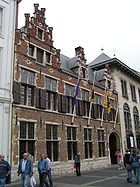
Rubenshuis
Encyclopedia


Rubens's house during his lifetime
A year after marrying Isabella BrantIsabella Brant
Isabella Brant was a Flemish artists' model, the first wife of painter Peter Paul Rubens. She was the daughter of Jan Brant, an important city official in Antwerp, and Clara de Moy. Brant married Rubens on 3 October 1609 in Saint Michael's Abbey, Antwerp. They had three children: Clara, Nikolaas...
in 1609, Rubens began construction on an Italian-style villa
Villa
A villa was originally an ancient Roman upper-class country house. Since its origins in the Roman villa, the idea and function of a villa have evolved considerably. After the fall of the Roman Republic, villas became small farming compounds, which were increasingly fortified in Late Antiquity,...
on the then-Vaartstraat (now the Wapper, 9-11), at the time located at the banks of the canal Herentalse Vaart. Rubens designed the building himself, based on studies of Italian Renaissance
Italian Renaissance
The Italian Renaissance began the opening phase of the Renaissance, a period of great cultural change and achievement in Europe that spanned the period from the end of the 13th century to about 1600, marking the transition between Medieval and Early Modern Europe...
palace
Palace
A palace is a grand residence, especially a royal residence or the home of a head of state or some other high-ranking dignitary, such as a bishop or archbishop. The word itself is derived from the Latin name Palātium, for Palatine Hill, one of the seven hills in Rome. In many parts of Europe, the...
architecture
Architecture
Architecture is both the process and product of planning, designing and construction. Architectural works, in the material form of buildings, are often perceived as cultural and political symbols and as works of art...
that also formed the basis of his Palazzi di Genoa. The layout included his home, studio, a monumental portico
Portico
A portico is a porch leading to the entrance of a building, or extended as a colonnade, with a roof structure over a walkway, supported by columns or enclosed by walls...
and an interior courtyard
Courtyard
A court or courtyard is an enclosed area, often a space enclosed by a building that is open to the sky. These areas in inns and public buildings were often the primary meeting places for some purposes, leading to the other meanings of court....
. The courtyard opens into a Baroque
Baroque
The Baroque is a period and the style that used exaggerated motion and clear, easily interpreted detail to produce drama, tension, exuberance, and grandeur in sculpture, painting, literature, dance, and music...
garden
Garden
A garden is a planned space, usually outdoors, set aside for the display, cultivation, and enjoyment of plants and other forms of nature. The garden can incorporate both natural and man-made materials. The most common form today is known as a residential garden, but the term garden has...
that he also planned.
In the adjacent studio he and his students executed many of the works for which Rubens is famous. He had established a well-organised workshop that met the demands of his active studio, including large commissions from England
England
England is a country that is part of the United Kingdom. It shares land borders with Scotland to the north and Wales to the west; the Irish Sea is to the north west, the Celtic Sea to the south west, with the North Sea to the east and the English Channel to the south separating it from continental...
, France
France
The French Republic , The French Republic , The French Republic , (commonly known as France , is a unitary semi-presidential republic in Western Europe with several overseas territories and islands located on other continents and in the Indian, Pacific, and Atlantic oceans. Metropolitan France...
, Spain
Spain
Spain , officially the Kingdom of Spain languages]] under the European Charter for Regional or Minority Languages. In each of these, Spain's official name is as follows:;;;;;;), is a country and member state of the European Union located in southwestern Europe on the Iberian Peninsula...
and Bavaria
Bavaria
Bavaria, formally the Free State of Bavaria is a state of Germany, located in the southeast of Germany. With an area of , it is the largest state by area, forming almost 20% of the total land area of Germany...
and other locations. He relied on students and collaborators for much of the actual work. Rubens himself, however, guaranteed the quality and often finished paintings with his own hand. In a separate private studio he made drawings, portraits and small paintings without the assistance of his students and collaborators.
Rubens's house after his lifetime
Rubens spent most of his lifetime in this palace, and it was only sold after his death. The city bought it in 1937, and after an extensive restoration the Rubenshuis was opened to the public in 1946. Dozens of paintings and artworks by Rubens and his contemporaries were installed in the rooms, as well as period furniture. Paintings include his early Adam and EveAdam and Eve
Adam and Eve were, according to the Genesis creation narratives, the first human couple to inhabit Earth, created by YHWH, the God of the ancient Hebrews...
(c. 1600) and a self portrait
Self Portrait
Self Portrait is singer-songwriter Bob Dylan's tenth studio album, released by Columbia Records in June 1970.Self Portrait was Dylan's second double album, and features mostly cover versions of well-known pop and folk songs. Also included are a handful of instrumentals and original compositions...
made when he was about fifty.
The Rubenianum, a centre dedicated to the study of Rubens, is in a building at the rear of the garden.

